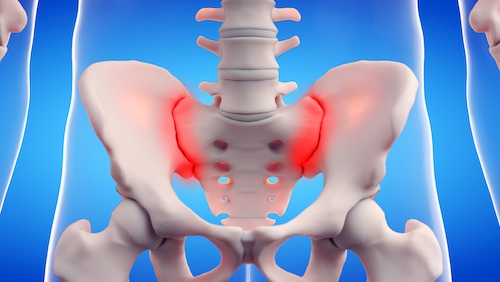Radiofrequency Ablation for SI Joint Pain: Understanding a Proven Option for Relief
We are VeriSpine Joint Centers. We treat chronic joint, spine, and soft tissue pain. We offer interventional pain procedures, physical therapy, regenerative medicine, and personal injury care. We serve Decatur, GA, and the greater Atlanta area. We accept federal workers’ compensation clients. Our team combines pain medicine expertise, imaging guidance, and patient-focused care. We aim to reduce pain, restore mobility, and help patients resume daily life with less dependence on pain medication.
Chronic pain from the sacroiliac joint can limit movement, disrupt sleep, and affect daily life. When physical therapy and pain medication no longer help, radiofrequency ablation offers a minimally invasive way to stop pain signals at their source. This treatment targets specific nerves that send pain messages from the lower back to the brain, providing long-lasting pain relief without major surgery.
At VeriSpine Joint Centers in Decatur, Georgia, our interventional pain procedures use precise image guidance and evidence-based methods to help patients manage joint pain and regain comfort in everyday activities.
Understanding SI Joint Pain (Setting the Scene)
Chronic pain in the lower back or buttocks often comes from the sacroiliac (SI) joint. Understanding how this joint works helps explain why radiofrequency ablation can be an effective treatment for pain relief.
What Is the Sacroiliac Joint?
The sacroiliac joint connects the sacrum at the base of the spinal column to the iliac bones of the pelvis. It supports the upper body and transfers weight to the legs. The joint allows limited movement but plays a key role in stability. When the joint becomes inflamed or its movement is restricted, pain signals travel through nearby nerves and cause discomfort.
Common Causes of SI Joint Pain
SI joint pain can develop from several conditions. Degenerative arthritis, trauma, pregnancy, and repetitive stress are frequent causes. Changes in posture or leg length differences may also strain the joint. In some patients, prior lumbar spine surgery increases stress on the sacroiliac joint, resulting in chronic pain. Inflammation of the joint’s nerve tissue may lead to constant aching or burning pain that worsens with movement.
Symptoms and Pain Patterns
SI joint pain often feels like lower back pain or hip pain. It may radiate into the buttocks, thigh, or groin. Some patients experience a tingling sensation or stiffness after sitting for long periods. The pain may increase when climbing stairs, standing, or changing position. Because these symptoms overlap with other spinal conditions, identifying the true pain generator is important for accurate diagnosis and treatment.
Diagnosis and Evaluation
Pain physicians use clinical tests, imaging, and diagnostic nerve blocks to confirm SI joint pain. Physical examination includes movement tests that reproduce symptoms. X-rays or MRI scans help rule out other causes, such as facet joint pain or disc problems. A local anesthetic injection into the sacroiliac joint can temporarily stop pain signals.
If pain relief follows the injection, the joint is likely the source. This information helps determine if a minimally invasive procedure like radiofrequency ablation could provide long-lasting pain relief.
The Importance of Accurate Diagnosis
Accurate diagnosis ensures the correct nerves responsible for pain are treated. Targeting the right area prevents unnecessary procedures and protects surrounding tissue.
At VeriSpine Joint Centers, our interventional pain procedures use image guidance and clinical data to identify the specific nerves and provide effective pain management. Proper identification of the pain generator is the first step toward restoring movement and reducing chronic pain.
What Is Radiofrequency Ablation (RFA)?
Radiofrequency ablation is a minimally invasive procedure that targets specific nerves to reduce chronic pain by disrupting their ability to send pain signals to the brain.
How Radiofrequency Ablation Works
During a radiofrequency ablation procedure, a pain physician uses a small hollow needle to reach the targeted nerve. A thin electrode is inserted through the needle, and radiofrequency energy passes through it. This energy creates controlled heat that destroys a small area of nerve tissue.
The heat stops the nerve from transmitting pain signals, providing long-lasting pain relief. The surrounding tissue remains unharmed because the heat is carefully focused on the targeted nerve.
The Science Behind Pain Relief
Nerves send electrical impulses to the spinal cord and brain whenever pain occurs. When a nerve is treated with radiofrequency energy, the damaged section can no longer send those pain signals.
The nerve’s ability to regenerate slowly over time means that pain relief may last for several months or longer. Most patients begin to feel improvement within a few days after the procedure, and relief may continue as inflammation decreases.
Types of Radiofrequency Ablation
Several methods of radiofrequency ablation are used in pain management. Continuous radiofrequency ablation applies steady heat to the nerve. Pulsed radiofrequency uses short bursts of radio waves at lower temperatures to reduce nerve activity without fully destroying the tissue.
Cooled radiofrequency ablation uses circulating water to create a larger treatment area while maintaining a lower temperature on the surrounding tissue. The technique chosen depends on the location of the pain, the type of nerve involved, and the patient’s response to previous treatments.
Safety and Precision in the Procedure
Radiofrequency ablation is performed under local anesthesia, sometimes with a mild sedative to help the patient relax. Imaging techniques such as fluoroscopy or ultrasound guidance ensure accurate needle placement.
Pain physicians may test for a tingling sensation or small muscle twitch to confirm the correct position of the electrode before applying heat. This careful approach minimizes the risk of nerve damage and ensures that only the nerves responsible for pain are treated.
Why Patients Choose Radiofrequency Ablation
Radiofrequency ablation is an effective treatment for joint pain, facet joint pain, and sacroiliac joint pain. It offers long-lasting pain relief without major surgery and allows most patients to return to normal activities within a short time.
At VeriSpine Joint Centers, our interventional pain procedures include radiofrequency ablation for patients in Decatur who need targeted, precise pain management solutions. This medical procedure can help reduce dependence on pain medication and improve daily function.
How RFA Is Used for SI Joint Pain
Radiofrequency ablation can reduce chronic pain in the sacroiliac joint by stopping specific nerves from sending pain signals to the brain.
Targeting the Right Nerves
The sacroiliac joint receives its pain signals from small nerves called the lateral branch nerves. These nerves connect the sacrum and iliac bone to the spinal cord. When these nerves become irritated, they send pain signals that cause joint pain and stiffness.
Before performing radiofrequency ablation, a pain physician uses diagnostic nerve blocks to identify which nerves are responsible. A small amount of local anesthetic is injected near the suspected nerve. If pain relief follows, those nerves are confirmed as the pain generator. This step ensures that the radiofrequency energy is applied only where it will be effective.
Step-by-Step Procedure
Radiofrequency ablation for SI joint pain is performed as an outpatient procedure. The patient lies comfortably while the treatment site is cleaned and numbed with local anesthesia. A mild sedative may be used to reduce anxiety.
Under fluoroscopy or ultrasound guidance, the physician inserts a hollow needle near the targeted nerve. A radiofrequency electrode is then placed through the needle. Electrical stimulation may create a tingling sensation, confirming the correct location before treatment. The physician then delivers controlled heat to the nerve tissue, stopping its ability to send pain signals.
Precision and Safety
Imaging guidance helps ensure proper needle placement and protects the surrounding tissue. The radiofrequency waves generate focused thermal energy only at the tip of the electrode. This precision minimizes the risk of nerve damage and reduces discomfort at the injection site.
After the procedure, patients rest briefly before going home the same day. Most patients return to normal activities within hours after the procedure. Some mild soreness at the treatment site is common but temporary.
Duration and Effectiveness
Pain relief from radiofrequency ablation varies by patient. Many experience long-lasting pain relief for six months to a year. The nerves responsible for pain can regenerate slowly, and the procedure may be repeated if pain returns.
Clinical data show that patients who respond well to diagnostic nerve blocks are more likely to benefit from RFA. At VeriSpine Joint Centers, interventional pain procedures like radiofrequency ablation are performed with precision to help patients in Decatur manage chronic SI joint pain and restore normal movement.
Benefits and Evidence
Radiofrequency ablation offers effective pain relief for patients with sacroiliac joint pain and other chronic pain conditions when conservative treatments are not enough.
Advantages of Radiofrequency Ablation
Radiofrequency ablation provides long-lasting pain relief without the need for major surgery. It is a minimally invasive procedure performed under local anesthesia, allowing patients to return home the same day. Most patients experience reduced pain and improved mobility within days.
The procedure can lower the need for long-term pain medication and improve participation in physical therapy. By stopping pain signals at their source, radiofrequency ablation helps patients regain normal activities and a better quality of life. For many people, it becomes an effective treatment that supports a long-term pain management plan.
Comparison to Other Treatments
Compared to steroid injections or nerve blocks, radiofrequency ablation offers longer pain relief because it targets the nerve tissue directly. It also avoids the potential side effects linked to repeated steroid use. In patients with severe pain who have not responded to medications or physical therapy, RFA provides a proven alternative before considering surgery.
Unlike open surgical options, radiofrequency ablation does not remove joint structures or require recovery from an incision. The targeted nerve treatment limits disruption to surrounding tissue and allows for faster recovery and lower complication risk.
Clinical Evidence and Results
Clinical data show that radiofrequency ablation can successfully treat sacroiliac joint pain, facet joint pain, and other spinal pain syndromes. Studies published by the Cleveland Clinic and the National Library of Medicine confirm that many patients experience significant pain reduction lasting six to twelve months or longer.
Some patients continue to experience benefits beyond a year, depending on how quickly the treated nerves regenerate. Research on cooled radiofrequency ablation and pulsed radiofrequency has also shown improved outcomes for certain nerve pathways. Pain physicians often use these variations based on the patient’s anatomy and previous methods that may not have provided relief.
Long Term Outcomes
Radiofrequency ablation does not cure the underlying joint disease, but it effectively interrupts the nerves responsible for pain. Because it is repeatable, patients can maintain relief when the nerves regenerate. Long-term follow-up has shown that repeated procedures remain safe and effective.
At VeriSpine Joint Centers, radiofrequency ablation is part of a comprehensive interventional pain procedure program. Patients in Decatur receive care guided by clinical evidence, imaging technology, and precise needle placement. The goal is to provide long-lasting pain relief and help patients return to their normal routine with less dependence on pain medication.
Take the Next Step Toward Lasting Pain Relief With Verispine Joint Centers!
If sacroiliac joint pain is limiting your daily life, our team at VeriSpine Joint Centers is ready to help. We specialize in interventional pain procedures, including radiofrequency ablation, to target the source of your pain and restore movement. Our experienced pain physicians in Decatur, Georgia, provide personalized evaluations and precise treatment plans designed to deliver real relief.
Contact us at 678-782-7999 to schedule an appointment today!







